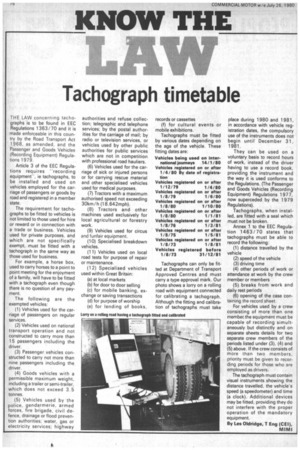KNOW THE
Page 78

If you've noticed an error in this article please click here to report it so we can fix it.
Tachograph timetable
THE LAW concerning tachographs is to be found in EEC Regulations 1363/70 and it is made enforceable in this country by the Road Transport Act 1968, as amended, and the Passenger and Goods Vehicles (Recording Equipment) Regulations 1979.
Article 3 of the EEC Regulations requires -recording equipment", ie tachographs, to be installed and used on vehicles employed for the carriage of passengers or goods by road and registered in a member state.
The requirement for tachographs to be fitted to vehicles is not limited to those used for hire or reward or in connection with a trade or business. Vehicles used for private purposes, and which are not specifically exempt, must be fitted with a tachograph in the same way as those used for business.
For example, a horse box, used to carry horses to a point to point meeting for the enjoyment of a family, will have to be fitted with a tachograph even though there is no question of any payment.
The following are the exempted vehicles: (1) Vehicles used for the carriage of passengers on regular services.
(2) Vehicles used on national transport operation and not constructed to carry more than 15 passengers including the driver.
(3) Passenger vehicles constructed to carry not more than nine passengers including the driver.
(4) Goods vehicles with a permissible maximum weight, including a trailer or semi-trailer, which does not exceed 3.5 tonnes.
(5) Vehicles used by the police, gendarmerie, armed forces, fire brigade, civil defence, drainage or flood prevention authorities; water, gas or electricity services; highway authorities and refuse collection; telegraphic and telephone services; by the postal authorities for the carriage of mail; by radio or television services, or vehicles used by other public authorities for public services which are not in competition with professional road hauliers.
(6) Vehicles used for the carriage of sick or injured persons or for carrying rescue material and other specialised vehicles used for medical purposes.
(7) Tractors with a maximum authorised speed not exceeding 30km /h (1 8.642mph).
(8) Tractors and other machines used exclusively for local agricultural or forestry work.
(9) Vehicles used for circus and funfair equipment.
(10) Specialised breakdown vehicles.
(11) Vehicles used on local road tests for purpose of repair or maintenance.
(12) Specialised vehicles used within Great Britain: (a) at local markets (b) for door to door selling (c) for mobile banking, exchange or saving transactions (d) for purpose of worship (e) for lending of books, Tachographs can only be fitted at Department of Transport Approved Centres and must carry a type approval mark. Our photo shows a lorry on a rolling road with equipment connected for calibrating a tachograph. Although the fitting and calibration of tachographs must take place during 1980 and 1981, in accordance with vehicle registration dates, the compulsory use of the instruments does not begin until December 31, 1981.
They can be used on a voluntary basis to record hours of work, instead of the driver having to use a record book, providing the instrument and the way it is used conforms to the Regulations. (The Passenger and Goods Vehicles (Recording Equipment) Regulations 1977, now superceded by the 1979 Regulations).
Tachographs, when installed, are fitted with a seal which must not be broken.
Annex 1 to the EEC Regulation 1463/70 states that tachographs must be able to record the following: (1) distance travelled by the vehicle (2) speed of the vehicle (3) driving time (4) other periods of work or attendance at work by the crew member or members (5) breaks from work and daily rest periods
(6) opening of the case containing the record sheet. For vehicles used by a crew
consisting of more than one member, the equipment must be capable of recording simultaneously but distinctly and on separate sheets details for two separate crew members of the periods listed under (3), (4) and (5) above. If the crew consists of more than two members, priority must be given to recording periods for those who are employed as drivers.
The tachograph must contain visual instruments showing the distance travelled, the vehicle's speed (a speedometer) and time (a clock). Additional devices may be fitted, providing they do not interfere with the proper operation of the mandatory equipment.
By Les Oldridge, T Eng (CE1),




















































































































